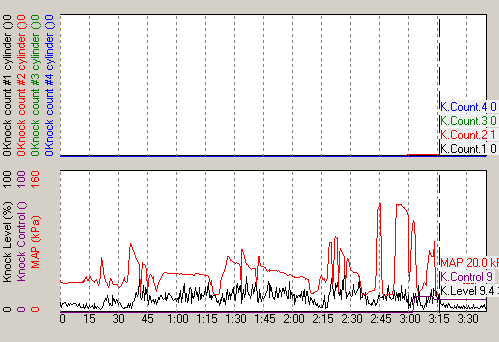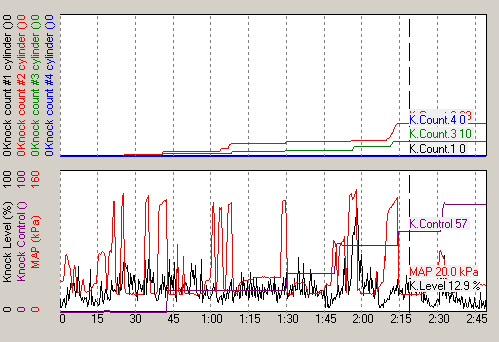In some situations it is necessary to alter the ignition advance for each individual cylinder. In this example for a Jackson Racing supercharged vehicle, the intake manifold does not flow as well for cylinders #1 and #4, resulting in lower cylinder pressures and decreased knock for those cylinders.
Initial Test
For our initial test the ignition timing tables we as set from a dyno session, with no cylinder ignition trim.

By placing the engine under full load on a test track we observed a single knock on #2 cylinder.


A single knock under high load over several minutes is acceptable - the car was dyno tuned so that it would knock. However, for this example we wanted to test a vehicle with knock, so the ignition timning was advanced.
Advanced Test
Since we wanted to determine the difference between cylinders and the knock count from our initial test was very low, we advanced the ignition timing by 3 degrees for all cylinders by setting the individual cylinder ignition trim.
Note that we are doing this for the purpose of illustrating how to tune the cylinder ignition timing - we don't recommend you just add several degrees ignition timing and see what happens.

Performing the same test procedure with the advanced ignition showed knock for cylinders #2 and #3, but none for #1 and #4.


Cylinders #2 & #3 have significant knock - this is because the manifold gives the most cylinder filling for these cylinders.
Adjusted Ignition
From the test setting the ignition was adjusted for each cylinder to give an even knock count.



Final Setting
Once the cylinder ignition timing was set, the timing was reduced by 1 degree for all cylinders to ensure that no knock would occur under normal driving conditions.

The final values on average were the same as the initial setting, but #2 & #3 were much less likely to knock, while #1 and #4 cylinders were advanced. This will give better detonation resistance as well as increased power from a better balanced engine.
There are other ways to determine individual cylinder trim - exhaust gas temperatures is the accepted normal method. Note also that if the end cylinder was not filling as well as the middle cylinders, then it is likely that the fuel mixture is not optimum for each cylinder as well.